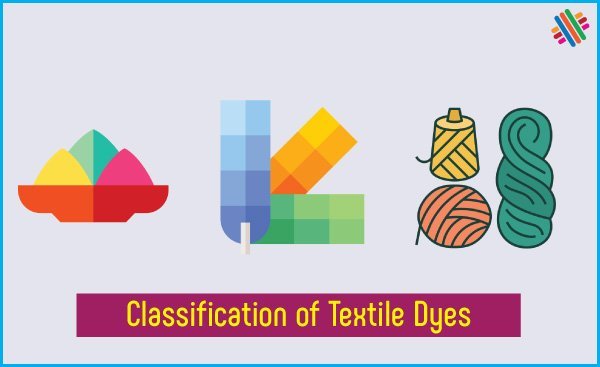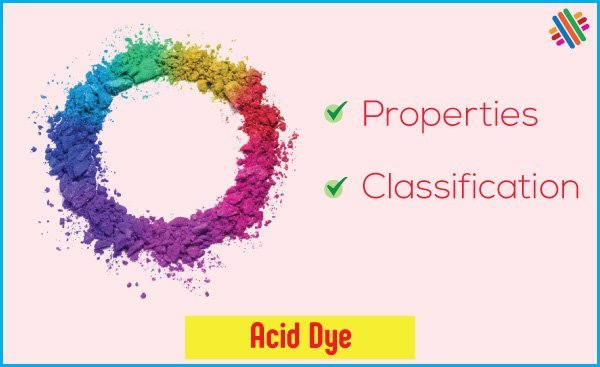Classification of Textile Dyes
Last updated on October 5th, 2023 at 05:58 pm
Dye is a complex compound which is applied in the textile materials represent color and contains chromophore and auxochrome groups in its chemical structure.

Dyes or dyestuffs are classified according to their chemical structure would form at least 30 classes. The important types are discussed below:
Acid Dyes
This is a large class characterized by their substantively for protein fibres (wool, silk). They are normally applied from an acid dye bath, and hence the name. They are also used for nylon dyeing and printing. ICI trademarks are ‘Lissamine’, ‘Coomasse’, ‘Carbolan’ and ‘Nylomine’ Acid. Acid dyes are anionic, i.e. the dye molecule is negatively charged.
Azoic Dyes
These are used in printing, mainly for cellulosic fibres (predominantly cotton). The characteristic feature of these dyes is that they are formed in situ within the fibre by the reaction of two components, i.e. the diazo component and the coupling component. These components are applied separately, i.e. the coupling component first, followed by the diazo component. A variety of chemical modifications to diazo compounds have enabled them to be mixed with coupling compounds without immediately generating the dyestuff. The dye is formed in a subsequent steaming operation. Trade names are ‘Brenthol’ and ‘Brenthamine’. The former Brentogen range was based on stabilized ‘Brentamine’ and ‘Brenthol’ mixtures, acid steaming being needed to form the dye. Ordinary steaming suffices to develop the ‘Neutrogen’ and ‘Rapidogen’ brands.
Basic Dyes
These dyes are cationic, i.e. the dye molecule is positively charged. To apply them to cotton it provide necessary to give a tannin mordanting treatment. The resulting fastness of the dyes was still only moderate and the style is now virtually obsolete. Basic dyes may be applied to wool and silk without mordant, but again the results are characterized more by brightness than fastness. Specially developed basic dyes are widely used on acrylic fibres, upon which they are quite fast. The ICI trade mark is ‘Synacril’.
Direct Dyes
The name arose from the fact that the dyes possessed direct substantivity for cotton, i.e. without the necessity for a pre-mordanting treatment. A wide range is available both in color and in fastness. The limiting factor for these dyes in printing is their lack of washing fastness even when given one of the various after treatments available. ICI trademarks are ‘Chlorazol’ and ‘Durazol’.
Disperse Dyes
These are water insoluble dyes sold as aqueous dispersions or as re-dispersible powders or grains. They were originally introduced for the dyeing of cellulose acetate. Modern disperse dyes are printed on ‘Terylene’ polyester fibre, cellulose acetate and cellulose triacetate. ICI trademarks are ‘Dispersol’, ‘Duranol’ and ‘Procinyl’ (disperse reactive type).
Mordant Dyes
These are are applied to the fibre in conjunction with a metal salt. The dye-metal complex possesses greater fastness than the dye alone. In spite of the fact that basic dyes were applied to cotton by means of a tannin-antimony mordant it is conventional to exclude such dyes from the mordant group. Similarly exclude are direct dyes requiring a metallic salt treatment to obtain full fastness. Some mordant dyes are of great antiquity many used even fifty years ago were of natural origin. Turkey reds, madder and alizarin reds all relied on an aluminium mordant while logwood blacks were based on iron. Chromium acetate was widely used in admixture with mordant dyes for cotton printing. These dyes are only very rarely encountered in modern textile printing.
Pre-metalized Dyes
These may be regarded as a later development of mordant dyes. Prior to their discovery wool had been mordant dyed by three processes:
- Applying a chromium salt to the wool before the dye (chrome mordant method).
- Applying the dye first and after treating with a chromium salt (the after chrome method).
- Applying the dye and chromium salt simultaneously (the Meta chrome method).
The difficulty especially in the after chrome method was due to color matching in the presence of an appreciable shade change. This led to research on performed dye-metal complexes. Swiss and German manufacturers achieved the first real success on wool in 1915, and introduced ranges of 1:1 chrome complex dyestuff. The strong acid necessary to dye these products led to further work. By linking chromium with two molecules of dye, the 1:2 chromium complexes were formed. These were easier to apply and are widely used in dyeing and to a lesser extent in printing. Trademarks are ‘Irgalan’ and ‘Cibalan’.
Onium Dyes
A small range of dyes which owe their name to the fact that they are either ammonium or sulphonium compounds. They are water soluble cationic dyes and hence must not be mixed with anionic dyes; otherwise they will participate with each other. In the presence of heat and alkali the solubilising groups split up to give a very fast dye on the fibre. This is an example of a temporarily solubilised dyestuff. Cotton is the most important fibre for onium dyestuff. The ICI trademark is ‘Alcian’.
Pigment Dyes
These products are insoluble in water and are preferably also insoluble in white spirit and in chlorinated solvents used in dry cleaning. In admixture with a suitable resin binder they may be printed on the majority of the textile fabrics. In recent years extensive research especially in USA and Germany has produced greatly improved binders. This has resulted in prints of much softer handle as well as better wet and dry rubbing fastness. The trademarks are ‘Aridye’ and ‘Hifast’ (Inmont, USA), ‘Acramin’ (F, Bayer), and ‘monolite’ and ‘Monastral’ (ICI).
Oxidation Dyes
In principle, a small molecular weight intermediate is treated under acid oxidation conditions to form a much larger colored molecule. These products have been most widely developed as hair and fur dyes. In printing, aniline black is still of importance, while diphenyl black is now little used although a solubilized derivative of the starting intermediate ‘Solonile’ black is of value in certain styles. Paramine brown, one of the few other oxidation colors formerly employed in textile printing, fell out of general use on fastness grounds.
Reactive Dyes
First marketed by ICI in 1956, this group of dyes owes their name to their ability to undergo a chemical reaction with cellulose fibres. This produces a covalent dye-fibre bond which gives dyeing and prints of excellent washing fastness. Reaction with wool and silk is also possible, while on nylon, although some of the dyes fix well, the molecular size of some of the others is too large to penetrate the nylon efficiently. Reactivity and hence dye stability may vary widely. It is usual to indicate differences in reactivity either by using two trademarks or by using two different letters and a single trademark, e.g. ‘Procion’ M (more reactive) and ‘procion’ H (less reactive) dyes.
Sulphur Dyes
These products may be dyed to give fabrics of good washing fastness at low cost. As a range they have never been successful in textile printing owing to erratic fixation. An exception is the sulphur black ‘Indicarbon’ CL (Casella) and its equivalents. These are printed alongside the cheaper members of the vat range where all round fastness requirements are not excessively stringent, e.g. dress goods, but not furnishings.
Vat Dyes
These are insoluble in water and contain keto groups. In alkaline solution a reducing agent, e.g. sodium hydrosulphite will produce a soluble leuco compound. It is the sodium salt of the leuco compound which dyes into the fibre. To obtain the vat dye back in its original form an oxidation treatment is necessary. Indigo is a vat dye and synthetic sulphur containing derivatives are termed thioindigoid vat dyes. The other and larger vat dye groups are termed anthraquinonoid vats. This broad classification is often used as the basis of dividing the dyes into two ranges by using two trademarks, e.g. ‘Durindone’ (for indigoid and thioindigoid vat dyes) and ‘Caledon’ (for anthraquinonoid vat dyes).
You may also like: Definition of Disperse Dye | Properties of Disperse Dye



